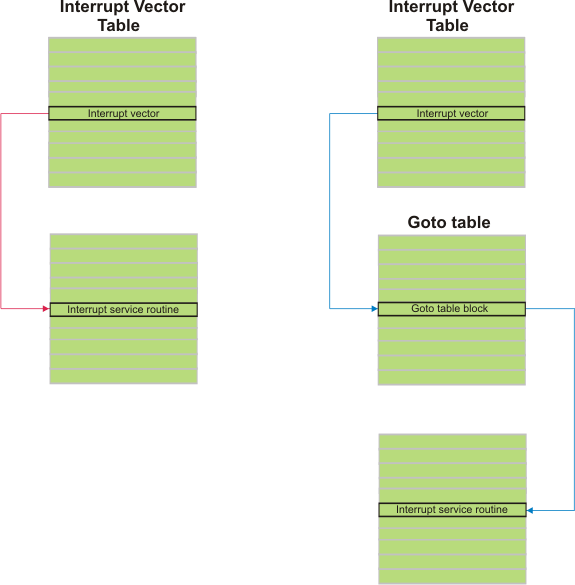Interrupts
AVR derivates acknowledges an interrupt request by executing a hardware generated CALL to the appropriate servicing routine ISRs.
ISRs are organized in IVT.
ISR is defined as a standard function but with the iv directive afterwards which connects the function with specific interrupt vector.
For example, 0x0008 is IVT address of Timer/Counter 2 Overflow interrupt source of the ATMEGA16, and the symbolic name for this interrupt vector in mikroBasic PRO for AVR is IVT_ADDR_TIMER2_OVF.
Symbolic interrupt name list can be accessed by using Code Assistant, i.e. by typing the IVT and pressing Ctrl+Space in the Code Editor.
For more information on interrupts and IVT refer to the specific data sheet.
Function Calls from Interrupt
Calling functions from within the interrupt routine is allowed. The compiler takes care about the registers being used, both in "interrupt" and in "main" thread, and performs "smart" context-switching between them two, saving only the registers that have been used in both threads. It is not recommended to use function call from interrupt. In case of doing that take care of stack depth.
Use the DisableContextSaving to instruct the compiler not to automatically perform context-switching. This means that no regiser will be saved/restored by the compiler on entrance/exit from interrupt service routine. This enables the user to manually write code for saving registers upon entrance and to restore them before exit from interrupt.
Interrupt Handling
For the sake of interrupt handling convenience, new keyword, iv, is introduced. It is used to declare Interrupt Vector Table (IVT) address for a defined interrupt routine :
sub procedure Timer1_Interrupt iv IVT_ADDR_TIMER1_OVF ' Dummy Timer1 interrupt routine
asm
nop
end asm
end sub
Now it is possible to explicitly declare interrupt routine address :
sub procedure Timer1_Interrupt org 0x600 iv IVT_ADDR_TIMER1_OVF ' Interrupt routine will be placed on the address 0x600
asm
nop
end asm
end sub
For the sake of backward compatibility, user may write also :
sub procedure Timer1_Interrupt org IVT_ADDR_TIMER1_OVF
asm
nop
end asm
end sub
which is equivalent to :
sub procedure Timer1_Interrupt iv IVT_ADDR_TIMER1_OVF
asm
nop
end asm
end sub
Is is recommended that interrupts are handled in this way for the sake of better readability of the user projects.
Interrupt Example
Here is a simple example of handling the interrupts from Timer1 (if no other interrupts are allowed) :
program Timer1_Interrupt
const _THRESHOLD = 10
dim counter as byte
sub procedure Timer1Overflow_ISR iv IVT_ADDR_TIMER1_OVF
if (counter >= _THRESHOLD) then
PORTB = not PORTB ' toggle PORTB
counter = 0 ' reset counter
else
Inc(counter) ' increment counter
end if
end sub
main:
DDRB = 0xFF ' set PORTB as output
PORTB = 0 ' clear PORTB
SREG_I_bit = 1 ' Interrupt enable
TOIE1_bit = 1 ' Timer1 overflow interrupt enable
TCCR1B = 2 ' Start timer with 8 prescaler
while TRUE
nop ' Endless loop, port is changed inside Interrupt Service Routine (ISR)
wend
end.
Most of the MCUs can access interrupt service routines directly, but some can not reach interrupt service routines if they are allocated on addresses greater than 2K from the IVT. In this case, compiler automatically creates Goto table, in order to jump to such interrupt service routines.
These principles can be explained on the picture below :

Direct accessing interrupt service routine and accessing interrupt service routine via Goto table.
What do you think about this topic ? Send us feedback!



